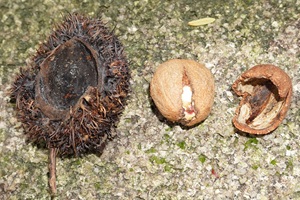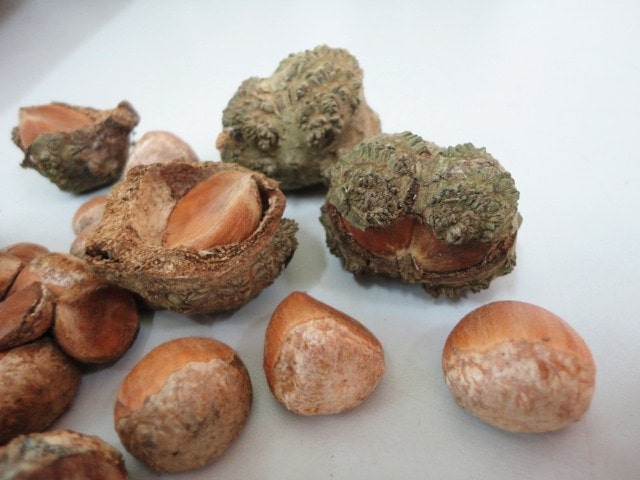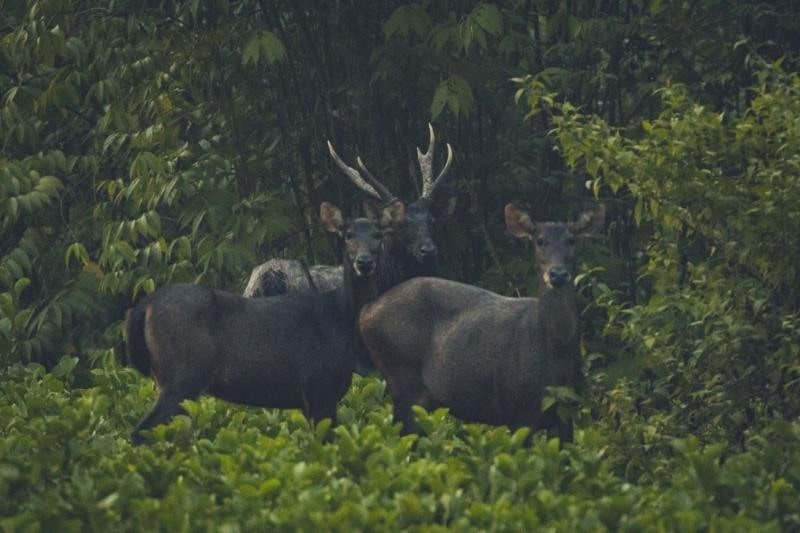Treasured Chest
Roasted chestnuts may not exactly be a festive December favourite in Singapore, but did you know there are some chestnuts that grow in Singapore? While these may not be the commonly eaten chestnut (Castanea mollissima), locally known as gao lak, these species are native to Singapore and are an important part of our local biodiversity.
Let’s learn more about these local chestnuts this season.
Braided Chestnut


Photo credit: Izzul Haq Abdullah
The Braided Chestnut (Castanopsis inermis) is a tree that grows to 16 to 30 m tall and is a tropical member of the oak family that can be found in Singapore, Peninsular Malaysia, and Indonesia.
The Braided Chestnut has cupules (outer layers) with three to four lobes marked with curving bands, enclosing the fruits completely. The fruits form in clusters of one to four, and densely covered with reddish-brown hair.
It has insect-pollinated flowers and is the preferred local food plant for caterpillars of the butterfly, the Ciliate Blue (Anthene emolus) and the moth Calliteara angulata. As part of habitat enhancement and conservation efforts for this Critically Endangered native species, it has been planted in Chestnut Nature Park.
Greater Malayan Chestnut


Photo credit: Reuben Lim
The Greater Malayan Chestnut (Castanopsis megacarpa) is a tree that grows up to 36 m tall. It has fissured bark and may also have buttress roots. Native to Singapore, it occurs locally in Bukit Timah Nature Reserve. It can also be found in Peninsular Malaysia and Borneo.
The Greater Malayan Chestnut has cupules with branched spines and enclose the egg-shaped fruits completely. It has insect-pollinated flowers and can be propagated by seeds.
Chinese Water Chestnut
.jpg?h=267&w=194)

Photo credit: Vicky Lim Yen Ngoh and Jennie Tang Yurue
The Chinese Water Chestnut (Eleocharis dulcis) is an aquatic plant with cylindrical straw-coloured flowers in clusters. Occurring locally in Sungei Buloh Wetland Reserve, it grows in open wet habitats such as freshwater swamps and ponds.
The plant is leafless. With the absence of leaves, photosynthesis is carried out by the culms or stems. These culms are grayish-green, smooth and hollow in the middle, and can grow up to 60 cm in height. It produces corms (underground tubers) that are sweet-tasting and can be eaten raw or cooked in stuffings, soups, salads, or steamed as a vegetable dish.
Learning More
If you are heading to our green spaces, do the right thing and be socially responsible. Maintain a safe distance from other park goers and keep to not more than five persons in a group, with no intermixing between groups. Always wear a mask except when you are engaged in strenuous exercise or when consuming food, drink or medication.
Do check out the visitorship levels of our parks using our safe distancing portal before you head down and avoid the ones with high visitorship.
Visit NParksSG, our refreshed YouTube Channel that serves as a one-stop repository for close to 300 video resources. It also provides you a platform for existing and future digital outreach including DIY gardening and related crafts, virtual tours of our green spaces, and livestream events.
Interested to learn about the flora and fauna found in Singapore? Visit NParks Flora & Fauna Web here.
If you like what you read, follow us on Facebook, Instagram and Telegram to get the latest updates.





Have views or comments on this article? Let us know via this form. If you would like to give us feedback on any other areas relating to our parks and gardens, please submit via https://www.nparks.gov.sg/feedback